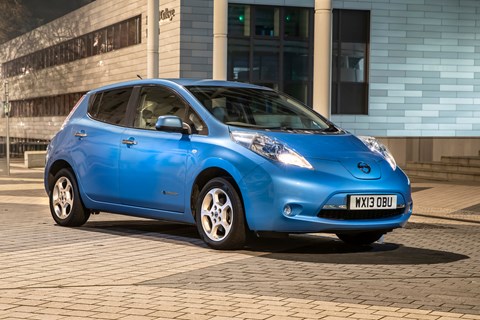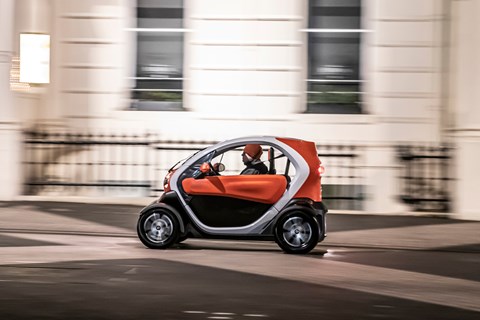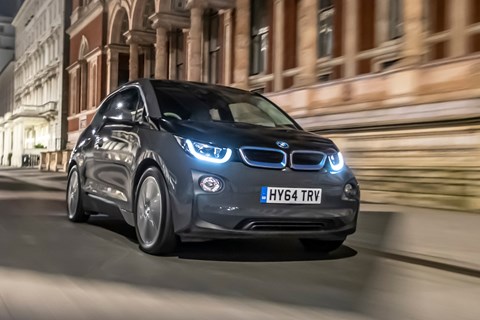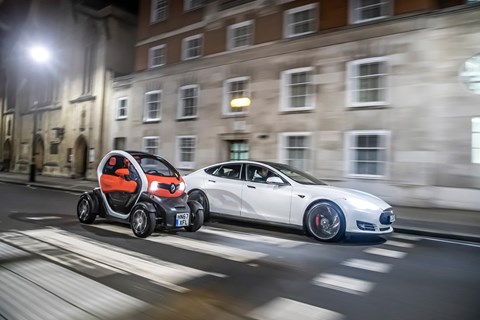► Petrol queues the final straw? Go electric
► Choice of sizes, shapes, prices
► Getting easier to live with all the time
Remember the G-Wiz? Remember when shopping for an electric car inevitably led you to the milk-carton-on-wheels with the cartoon face and 35-mile range? How things have changed.
Historians will say the revolution really began – very slowly – in 2010, when Nissan unveiled its ground-breaking Leaf. Here was a mainstream manufacturer launching a serious electric vehicle (EV) with everything a British buyer needed: five doors, frumpy looks and claimed range of 110 miles.
Which means (sound the fanfare!) the electric era is now firmly under way, and the secondhand market is flourishing. But as used EVs become more affordable, does that mean they're actually a good idea? What about the batteries? What about the range? And are they all as much fun to drive as an electric toothbrush? On a freezing cold night in London, we sample five used EVs to find out.
The best-seller: Nissan Leaf

What is it?
The Nissan Leaf was first unveiled in 2010. It went on sale in 2011 and it's been built in Sunderland since 2012.
History
The Leaf was launched with a 24kWh battery and a pale interior. In 2013 a heat pump was added as standard and the car got a darker interior. Battery was upgraded in 2016 to 30kWh. Early cars only had a pale interior. The whole car was revised in 2018 with more conventional styling and a 40kWh battery pack, improving the range to around 160 miles.
How much?
An early 11-plate starts around £7k, while a 2016-17 30kWh car with a 120-mile range is around £10k-£14k. A 40kWh new shape from 2018 will be £20k-£24k. There are plenty of used Leafs to choose from – thanks to it being such a big seller – or a brand new Leaf will cost from £26k.
What to look for
Like the Renault Zoe, the Leaf was available with a leased battery, which obviously adds to the running costs. Each car comes with a coded SD memory card which is very expensive to replace.
We must start, of course, with the bug-eyed Leaf, the best-selling EV of all time.
The example here has been loaned to us by EV Experts in Guildford, founded in 2017 by Martin Miller and business partner Estelle Symonds. It's a 2013 Launch Edition. Such an early example means a 24kWh battery, a 107bhp motor and forget that claimed 110-mile range: in the real world, this Leaf would only do 80 when new; eight years later, it's more like 70.
Plus, cars from the first two years of Leaf production weren't fitted with a heat pump, the most efficient way of heating the cabin, so they're extra sensitive to cold conditions. 'You can blast 10 miles of range just by turning on the 3kW bar heater,' Martin explains. 'But,' he adds, 'the sub-£10k Leaf market is buoyant: there are lots of people who'll pay £8k, because if your commute is only 15 miles a day, why not?'
Sure enough, as we climb aboard to drive into central London, the indicated 69-mile range immediately drops as I turn on the heater. So I turn it off again, and – shivering in the misted-up, ice-box interior – conclude these early EVs really are for guilt-ridden, lentil-eating, hairshirt types.
As we drive in, Martin explains how all the data from Tesla, Nissan and BMW suggests you lose around one to two per cent of battery range per year; and it's time, not miles, that does the damage, because the plastic polymers in the batteries decay. More miles, and lots of healthy charging, is actually good for a battery. 'Low-mileage cars are something we steer clear of,' says Martin. 'A four-year-old EV that's only got 1200 miles on the clock – we'd test the battery before we'd buy.'
In such a topsy-turvy world, the Leaf is soothingly ordinary to drive. With no rattly diesel up front, it makes serene progress through town. The interior has wide armrests in the doors and a large centre box, and in no time I find myself sitting back in the comfy armchair, elbows out, driving with my fingertips. No gears, no bother. It's not a thrilling car to drive; that instant torque of EV legend is certainly there, but only as a pleasant surge in traffic. Ultimately, this car feels numb.
Still, I shouldn't be harsh: it's tax-free, fuel-free, Congestion Charge-free, right?
The bargain: Renault Zoe

What is it?
After various Zoe concepts, the production car was unveiled in 2012, part of a three-pronged EV push from Renault along with the electric Fluence saloon and Twizy. Zoe deliveries in the UK began in March 2013.
History
Early Zoes have a 22kWh battery. A bigger 41kWh battery was introduced in 2016, called the ZE40. In 2018 the motor power was increased to 109bhp, and in 2019 the car was upgraded again with a 55kWh battery pack and a 134bhp motor. New cars are sold with the battery, so no more leasing.
How much?
Pricing is all about that battery lease: if you have to take on a £49 monthly payment, prices start at £6k-£7k; add £5k for a 'battery owned' example. The latest Zoe, brand new, is priced from £27,595.
What to look for
Front suspension is a weakness. Renault recommends you don't jack the car up to change a wheel, so tyre condition is a factor. The tailgate is known to squeak.
We arrive in London to meet the rest of the CAR team and I jump into the Renault Zoe. This 16-plate car was run by our own Steve Moody as a CAR long-term test car back in 2016 and he liked it so much he ended up buying it. It has a 22kWh battery and 65KW (87bhp) motor and, according to Steve, a range of around 80 miles.
Climbing in, it's another conventional interior but it does drive with a bit more va-voom than the Leaf. The steering feels alive and it corners with a flat confidence, thanks to the battery in the floor. Unfortunately, like the Leaf, it's heavy – roughly 200kg more than a Clio – which dulls that torquey EV acceleration.
There are complications to buying a used Zoe too. When it was launched in 2012, Renault was convinced battery degradation would be an obstacle to customers, so it offered a battery lease: 45 per cent of owners bought Zoes outright, 55 per cent leased the battery, paying Renault a monthly fee. If you buy a secondhand battery-lease Zoe, you take over the payments. Early 22kWh cars cost between £49 a month for up to 4500 miles a year and £99 per month for 12,000 miles (later 40kWh cars are £10 more).
This lease agreement wasn't popular when the car was new and it's even less so in the used market, especially as the batteries have proved to be strong. Renault finally dropped the lease model in February 2020, and it's now allowing owners to buy out old leases, based on a 10 per cent reduction in value per year. Renault prices the Zoe battery at €7000 plus VAT, so a four-year-old battery like this one will cost around £5000 to own outright – a chunk of wedge on top of the car purchase price.
Not only that, Zoes are renowned for being tricky to charge. Martin says: 'When you plug in any EV, it does a check before it starts taking on charge, to make sure that everything's grounded. Zoes need more ground than other EVs. So, for example, the Waitrose in Guildford has four charging points, but a Zoe won't charge on the fourth one – a Leaf or BMW will, but a Zoe will not.'
I asked Renault about this, and it replied, 'All reputable charging point installers provide adequate earthing for charging units, so it's likely that if anyone had an issue it would relate to their specific home wiring situation'. But Steve agrees with Martin: 'It's definitely an issue.'
The oddball: Renault Twizy

What is it?
Launched in 2011, the Twizy is classed as a quadricycle, not a car. It seats two, the passenger behind the driver, but a Cargo version is also available (the rear seat replaced with a lockable box). Until recently, every Twizy was battery-leased, but old leases can now be bought out.
History
All British Twizys have a 6.1kWh battery located underneath the front seat and a 17bhp motor. France got a less powerful 5bhp version, the Twizy 45: interestingly, when the UK harmonised its driver licensing laws with the EU in 2013, it meant British 16-year-olds could legally drive a 'light quadricycle' – ie an imported French Twizy 45.
How much?
High-mileage battery-lease cars start around £6k; a brand new Twizy is £12k.
What to look for
With simple mechanics and a sparse interior, very little goes wrong with the Twizy. Look out for extras like alloy wheels and Bluetooth audio.
If Martin is wary of trading Zoes, he's never touched a Twizy: even in the world of EVs, this is an oddball. Our example is a 67-plate but Twizy spec hasn't changed since launch in 2011. Twizys come with a tiny 6kWh battery under the front seat, and all Twizy batteries are leased (though like the Zoe, 2020-on cars are now sold 'battery owned' and used Twizy customers can buy out their leases). The Twizy's three-pin-plug charging cable is built into the nose, so no rapid charging; but the small battery means recharging from empty takes about three hours. Expect to get 35-40 miles out of that.
In France, Renault offered a Twizy 45 (5bhp, 45km/h top speed) but the UK only got the Twizy 80 (17bhp and 80km/h – 50mph – top speed). To date, Renault UK has sold more than 600, 90 per cent of which have the scissor doors. Bear in mind, the doors cannot be retro-fitted.
Tonight, in the cold, I should be grateful for our car's doors, with their zipped plastic windows, but the narrow cabin feels claustrophobic. The Twizy is only pointy-elbow wide and I soon stop to remove the windows so I don't feel like I'm trapped in a pushchair under a raincover.
After the Zoe, the Twizy interior feels cheap: it's a world of hard plastics; and when you get going, it sounds like a milk-float, with a loud 'Vvvwwuupppp!' motor noise. Yet, despite these shortcomings, it is hard not to love. It's so different from a regular car, so nippy and fun. The steering isn't as direct as you'd hope but it still feels like you can dart through junctions and slice into traffic. It seems daring and illegal to drive, like you're joyriding a shopping trolley.
And the Twizy does seem to be reliable. You won't see many outside of city centres – the only place where they really make sense – but owners do tell you that they're not just fun but trusty too. They're still available new, priced from around £12k, or buy a used one for half that, look after it, and you can expect it to have kept its value after a couple of years of use.
The classy choice: BMW i3

What is it?
BMW's 'i' sub-brand was launched in 2011 with the carbon i3 and mid-engined i8 supercar. The production i3 arrived in 2013.
History
The i3 was launched with two drivetrains: a full battery EV (BEV) with a 22kWh battery, or a battery plus a 650cc scooter engine acting as a range-extending generator (REX). In 2016 the battery grew to 33kWh, offering a 120-mile range. In 2019 the battery grew to 42kWh, boosting range to 160 miles. A more powerful, 182bhp S version was launched and the REX was dropped.
How much?
22kWh with rapid charging from about £14k; up to £18k for the 22kWh REX. A 33kWh BEV starts at £16k, REX from £18k; and the latest 42kWh starts at £25k on the used market; a new i3 will cost you £34k.
What to look for
Very few issues: spec varies a lot, bodywork is expensive to fix, REX fuel pressure sensors are prone to fail.
After all these Nissan-Renaults, the BMW i3 is a revelation – as it was when it was launched. Now eight years old, it still feels like the future: made from carbon with 'suicide' rear doors and skinny, 19-inch wheels, its proportions are unlike anything else. Inside, the dashboard has a futuristic vibe too, with thin, shapely seats and an open, minimalist dash. It's like climbing into a concept car.
This example is an early 64-plate with 40,000 miles. Annoyingly, BMW describes its batteries in amp-hours rather than the conventional kilowatt-hours – probably because, at launch, the i3's 22kWh battery sounded smaller than the Leaf's 24kWh, so they called it a '60Ah' instead. The i3's light weight and regenerative braking gave it a similar range to the Leaf anyway, of around 80 miles.
Ah yes, the regenerative braking. Not only does the i3 look different, it's a singular driving experience too. With its rear-drive and narrow tyres, the steering is razor sharp – I mean, so pointy it feels hyper-nervy at first. Also, the regen braking effect is calibrated to increase over the last few millimetres of throttle travel – in other words, coming off the accelerator is like pressing on the brakes. At first it makes for a jumpy drive but it's amazing how quickly you get used to it. With a bit of anticipation at traffic lights, I'm soon driving with just one pedal.
I absolutely love the i3. The visibility over that low dashboard, the build quality, the laser-precise dynamics – it's the first car tonight that makes me want to sign up to the revolution right away.
Sadly, it's not that easy, because used i3s are expensive. 'In the first two years of production, rapid charging was an option, and cars without this are a lot less,' Martin explains. 'Cars like this, a 60Ah [22kWh] with rapid charging, are more like £14k-£15k; but, as with every BMW, it's all about the spec.'
This is surely the flaw in EV economics: they work best as a second car, the short-haul, school-run shopper; but why spend £20k on a car that does 12 miles a day, when you could buy a 1.2 Volkswagen Polo for under £10k?
The fast one: Tesla Model S

What is it?
Weird to think that the first Tesla was the Elise-based Roadster back in 2008. The car that moved the company from irrelevant to revolutionary was the Model S, unveiled in 2009 and on sale (with RHD) in the UK in 2014.
History
Tesla battery packs have grown from 60kWh to 70, 75, 85, 90 and on to 100kWh (2016); in 2014 the all-wheel Dual Drive option was added, designated by a D badge. A Ludicrous Mode option was made available in 2015 and made available as a retrofit upgrade in 2016. The car also underwent a mild facelift in 2016, adding adaptive LED headlights and changing the black nose to a body-coloured 'facia'. All Teslas continue to evolve, often with little fanfare, so check carefully the spec of any particular model on offer.
How much?
An early 60kWh car starts at around £25k, growing to £50k-£60k for a free-Supercharging 90D, and hitting six figures for low-mile, high-performance variants. Bear in mind that new prices for the Model S start at £74k.
What to look for
Free, transferrable Supercharging has been offered and removed over the years, so check the status of individual cars. Screens go yellow and Tesla won't replace under warranty.
Tesla is the brand that's shown there is an appetite for expensive EVs, if they come with the right technology, performance and infrastructure.
Our example is a 2015 Model S P90D, which means a 90kWh battery, all-wheel-drive and 532bhp. Despite being a clean-sheet design with a 'skateboard' chassis, the Model S has conventional styling and apart from the giant touchscreen a surprisingly ordinary interior too. It feels big, bloated and American.
Despite this, the Tesla has a trick up its sleeve: it'll drag-strip away from a traffic light like a rocket. It is unbelievably fast. In town it has a fussy ride and a lazy steering feel but that potential under your right foot makes it an exciting drive.
But as I say, owning a Model S is about more than the warp-speed performance, it's also about infrastructure : Tesla's bespoke charging network now has more than 70 locations and more than 600 Superchargers than can deliver a peak charge rate of up to 250kW – a huge advantage over the usual 50kW rapid charging (though older Teslas like this can only charge at a peak 120kW rate).
Energy pricing is a big factor in buying a used Tesla, with electricity charged at a competitive rate, but before January 2017 cars were sold with a lifetime of transferable free Supercharging. Factor in the upgrades that Tesla has rolled out over the years, and you've got a class of highly sought-after 'unicorn' cars; sold after August 2016 (so they have the 'Autopilot 2' Hardware allowing Enhanced Autopilot), but before January 2017, benefiting from that free Supercharging.
Even apart from these gems, used Model S prices are strong, with 50,000-mile, free-Supercharging P90Ds going for £40k-£50k. It helps that Teslas have proved to be so robust, with US rental companies like Tesloop stretching Model Ss up to 300,000 miles. Battery degradation isn't an issue and – apart from a problem with yellowing touchscreens – even the interiors are proving reasonably tough.
So, should you?

This brief dive into used EVs hasn't raised any real horror stories. I approached this group feeling quite sceptical, but was actually pretty impressed. Only those steep secondhand prices stand in the way – otherwise I'd be driving a BMW i3 next week.
I admit, I'm surprised – I'd heard anecdotes about cars refusing to charge and dead electronics, but talking to owners and dealers like Martin, no one sounded any alarms. More than a decade into our great automotive experiment, the batteries are lasting well, and the improving infrastructure is making EVs easier to own and run.